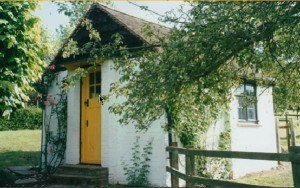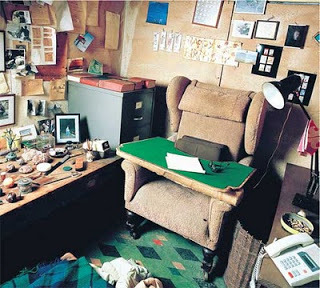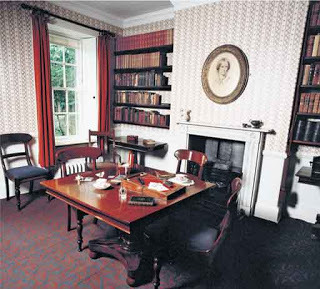Shedding some light
 For a small establishment, this building has generated a lot of heat in the last two days. Know what it is? Roald Dahl's writing shed. It's not looking so good these days apparently. It is going the way of all sheds, when the Ronseal eventually fails to preserve them. Wood, like flesh, in the end will rot.
For a small establishment, this building has generated a lot of heat in the last two days. Know what it is? Roald Dahl's writing shed. It's not looking so good these days apparently. It is going the way of all sheds, when the Ronseal eventually fails to preserve them. Wood, like flesh, in the end will rot.It's in the news because Dahl's granddaughter Sophie, the supermodel, appeared on the Radio 4 Today programme and explained that the contents of the shed needed to be moved to the Roald Dahl Museum nearby in Great Missenden, to be preserved and exhibited as her grandfather left them.
So far, so mildly interesting. But what has caused the Twitterverse and Blogosphere generally to explode is that she said this archiving and preservation (of the contents, not the building) would cost £500,000. She then seemed to be asking for contributions from the public.
 This is it: all there is. And it got me thinking. I'm not a big Dahl fan but many, many people are and doubtless would like to visit what will be a
This is it: all there is. And it got me thinking. I'm not a big Dahl fan but many, many people are and doubtless would like to visit what will be afacsimile of the interior you see here. So I asked myself if I would go and if I would be willing to contribute hard cash to a project to preserve the working space of a writer I did admire. Calvino, say, or Joyce, or Terry Pratchett.
I have visited Jane Austen's house at Chawton and the Haworth Parsonage, wondered at the smallness of the rooms in comparison with the largeness of the works written therein. And been mildly interested to see pens and inkwells, tables, beds and chairs.
The last famous person's home/museum I visited was Gustav Holst's in Cheltenham. It really was quite interesting, especially the kitchen of the period.
But it satisfies an idle sort of curiosity. It doesn't even begin to compare with reading Emma or Jane Eyre or listening to The Hymn of Jesus (better yet, singing it). It's part of the passion for biography which now seems to be an accepted way of shedding light on the works of a creative person. I read them just as much as anyone else does and sometimes I wish I hadn't. I could have done without knowing that Proust drive long pins into live rats - the only fact that sticks in my mind from George Painter's biography.

But if you read James Shapiro's excellent Contested Will, you discover that biography is a very young branch of the literary arts, and reading someone's life into their work even younger.
Philip Pullman wrote in a shed, before his huge success with His Dark Materials enabled him to buy a house with an indoor study. Many of my writer friends have sheds; Linda Strachan calls hers Tuscany. When Pullman moved house he gave his to a writer-illustrator friend, who demolished and reconstructed it in his own garden. It even still had plot post-its adhering to the walls.
One practical writing space practically handed on to another creative person. Not magic, not biography, not - heaven preserve us - "inspiration." And certainly not requiring half a million pounds. I imagine a pint changed hands in an Oxford pub or perhaps a bottle of wine was given. I like that story better.
Published on September 14, 2011 13:45
No comments have been added yet.
Mary Hoffman's Blog
- Mary Hoffman's profile
- 591 followers
Mary Hoffman isn't a Goodreads Author
(yet),
but they
do have a blog,
so here are some recent posts imported from
their feed.



